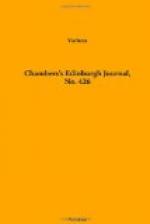Another view of this plan may be taken. Suppose ten, or twenty, or thirty persons of narrow means were to associate for the purpose of taking some large, old-fashioned house in the country—many such may be found—and agree upon a joint scheme of cheap living and independent labour, plain and economical dress, plain furniture, and a simple but wholesome table: would not this be better than all the risks and privations of expatriation? The Americans do not emigrate—they migrate; and there are spots in any of these three kingdoms, as wild, as solitary, and as healthful, as can be found in the regions of the Far West. But we do not, however, suggest migration as a substitute for genteel emigration—although we suspect it would in many cases prove so—but merely as a step towards it—a school of trial, or training, or both.
COLOURS IN LADIES’ DRESS.
Incongruity may be frequently observed in the adoption of colours without reference to their accordance with the complexion or stature of the wearer. We continually see a light-blue bonnet and flowers surrounding a sallow countenance, or a pink opposed to one of a glowing red; a pale complexion associated with a canary or lemon yellow, or one of delicate red and white rendered almost colourless by the vicinity of deep red. Now, if the lady with the sallow complexion had worn a transparent white bonnet; or if the lady with the glowing red complexion had lowered it by means of a bonnet of a deeper red colour; if the pale lady had improved the cadaverous hue of her countenance by surrounding it with pale-green, which, by contrast, would have suffused it with a delicate pink hue; or had the face
’Whose
red and white,
Nature’s own sweet and
cunning hand laid on,’
been arrayed in a light-blue, or light-green, or in a transparent white bonnet, with blue or pink flowers on the inside—how different, and how much more agreeable, would have been the impression on the spectator! How frequently, again, do we see the dimensions of a tall and embonpoint figure magnified to almost Brobdignagian proportions by a white dress, or a small woman reduced to Lilliputian size by a black dress! Now, as the optical effect of white is to enlarge objects, and that of black to diminish them, if the large woman had been dressed in black, and the small woman in white, the apparent size of each would have approached the ordinary stature, and the former would not have appeared a giantess, or the latter a dwarf.—Mrs Merrifield in Art-Journal.
SITTING ON THE SHORE.
The tide has ebbed
away;
No more wild surgings ’gainst
the adamant rocks,
No swayings of the sea-weed
false that mocks
The hues of gardens
gay:
No laugh of little
wavelets at their play;
No lucid pools reflecting
heaven’s broad brow—
Both storm and calm alike
are ended now.




